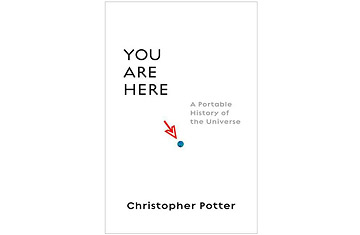
You Are Here: A Portable History of the Universe
By Christopher Potter
304 pages; Harper
The Gist:
"We do not like to think about the universe because we fear the immensity that is everything," writes Christopher Potter in You Are Here. A former literary publisher, Potter set aside that all-too-common fear and got to writing a layman's guide to the universe, a relatively brief look at how the breadth of scientific theory has evolved since the birth of mankind. Along the way, he makes the case for why scientific inquiry should be engaged in even by non-scientists. "Who can deny the universe when there is so much of it?" (Read "Nicaragua's Vampire Problem.")
Highlight Reel:
1. On the trickiness of light: "Kepler's supernova is 13,000 light-years away and is the most recently observed supernova in our galaxy. At the time, Kepler's supernova shone almost as brightly as Venus for several weeks. The bright light that those first observers recorded had traveled for 13,000 years to reach them. The light from Venus, however, takes only a few minutes to reach us. We look out into the night sky and record an impression of what is out there and we are inclined to think that that is how it is now, at this moment. Yet that now is made up of many nows, overlaid to make what we take to be a record of some event in the life of the universe rather than some subjective experience. Where now is in the universe is no more apparent than where its center is."
2. On big things: "The largest object so far discovered in the universe is called the Sloan Great Wall...It is a filament of superclusters and clusters of galaxies about 1 billion light years away and almost 1.5 billion light-years long. It would take 250,000,000,000,000,000 copies of the Great Wall of China placed end to end to cover this distance."
3. On how quantum theory is...complicated: "In quantum field theory, nature has been reduced to energetic fields made out of dimensionless (and, seen from the perspective of the classical world, non-existent) particles that causelessly and randomly come into and out of existence. It is pretty much impossible for the non-mathematician to understand how such a description might relate to the physical world. Quantum field theory is so abstract and mathematical that we really have little choice but to accept that such a description works."
The Lowdown:
Potter sees science as a matter of measurements. Accordingly, he utilizes distance, time, and size as our tour guides. First, we travel outwards from Earth, flying by the planets, over the Kuiper belt, through the Oort cloud (what names!), and past the Orion Nebula, the Hydra-Centaurus supercluster and beyond. Then we venture downward in magnitude — atoms and quarks and gluons and strings and Higgs bosons. There are also journeys forward from the big bang and the creation of Earth. In between, he stuffs his pages with musings on scientific history, philosophy, and personalities.
So, yes, the book's claim to be a "history of the universe," while not verifiable by the laymen for which Potter writes, at least feels like it might be truer than not. He occasionally gets lost in the weeds — a digression on the many variations of early man (homo ergaster, homo heidelbergansis, etc.) is eye-blurring, and humorously close to tales of Biblical lineage ("...And Isaac begat Jacob, and Jacob begat Judas..."). There's too much in here to internalize on one reading, so — and what more praise does a book need — you're going to have to read it again. Even then, to paraphrase Potter's quote of the wise Thomas Edison, you probably still won't know a millionth of one percent about anything.
The Verdict: Read
